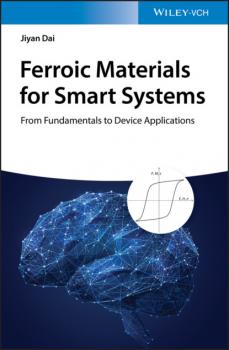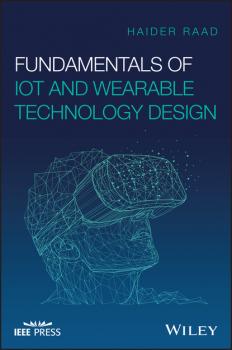ТОП просматриваемых книг сайта:
Техническая литература
Различные книги в жанре Техническая литература, доступные для чтения и скачиванияАннотация
Presents state-of-the-art knowledge?from basic insights to applications?on ferroic materials-based devices <br> <br> This book covers the fundamental physics, fabrication methods, and applications of ferroic materials and covers bulk, thin films, and nanomaterials. It provides a thorough overview of smart materials and systems involving the interplays among the mechanical strain, electrical polarization, magnetization, as well as heat and light. Materials presented include ferroelectric, multiferroic, piezoelectric, electrostrictive, magnetostrictive, and shape memory materials as well as their composites. The book also introduces various sensor and transducer applications, such as ultrasonic transducers, surface acoustic wave devices, microwave devices, magneto-electric devices, infrared detectors and memories. <br> <br> Ferroic Materials for Smart Systems: Fabrication, Devices and Applications introduces advanced measurement and testing techniques in ferroelectrics, including FeRAM and ferroelectric tunnelling based resistive switching. It also looks at ferroelectricity in emerging materials, such as 2D materials and high-k gate dielectric material HfO2. Engineering considerations for device design and fabrication are examined, as well as applications for magnetostrictive devices. Multiferroics of materials possessing both ferromagnetic and ferroelectric orders is covered, along with ferroelastic materials represented by shape memory alloy and magnetic shape memory alloys. <br> <br> -Brings together physics, fabrication, and applications of ferroic materials in a coherent manner <br> -Discusses recent advances in ferroic materials technology and applications <br> -Covers dielectric, ferroelectric, pyroelectric and piezoelectric materials <br> -Introduces electrostrictive materials and magnetostrictive materials <br> -Examines shape memory alloys and magneto-shape-memory alloys <br> -Introduces devices based on the integration of ferroelectric and ferromagnetic materials such as multiferroic memory device and ME coupling device for sensor applications <br> <br> Ferroic Materials for Smart Systems: Fabrication, Devices and Applications will appeal to a wide variety of researchers and developers in physics, materials science and engineering. <br>
Аннотация
Broad coverage of digital product creation, from design to manufacture and process optimization This book addresses the need to provide up-to-date coverage of current CAD/CAM usage and implementation. It covers, in one source, the entire design-to-manufacture process, reflecting the industry trend to further integrate CAD and CAM into a single, unified process. It also updates the computer aided design theory and methods in modern manufacturing systems and examines the most advanced computer-aided tools used in digital manufacturing. Computer Aided Design and Manufacturing consists of three parts. The first part on Computer Aided Design (CAD) offers the chapters on Geometric Modelling; Knowledge Based Engineering; Platforming Technology; Reverse Engineering; and Motion Simulation. The second part on Computer Aided Manufacturing (CAM) covers Group Technology and Cellular Manufacturing; Computer Aided Fixture Design; Computer Aided Manufacturing; Simulation of Manufacturing Processes; and Computer Aided Design of Tools, Dies and Molds (TDM). The final part includes the chapters on Digital Manufacturing; Additive Manufacturing; and Design for Sustainability. The book is also featured for being uniquely structured to classify and align engineering disciplines and computer aided technologies from the perspective of the design needs in whole product life cycles, utilizing a comprehensive Solidworks package (add-ins, toolbox, and library) to showcase the most critical functionalities of modern computer aided tools, and presenting real-world design projects and case studies so that readers can gain CAD and CAM problem-solving skills upon the CAD/CAM theory. Computer Aided Design and Manufacturing is an ideal textbook for undergraduate and graduate students in mechanical engineering, manufacturing engineering, and industrial engineering. It can also be used as a technical reference for researchers and engineers in mechanical and manufacturing engineering or computer-aided technologies.
Аннотация
A comprehensive guide to modern-day methods for earthquake engineering of concrete dams Earthquake analysis and design of concrete dams has progressed from static force methods based on seismic coefficients to modern procedures that are based on the dynamics of dam–water–foundation systems. Earthquake Engineering for Concrete Dams offers a comprehensive, integrated view of this progress over the last fifty years. The book offers an understanding of the limitations of the various methods of dynamic analysis used in practice and develops modern methods that overcome these limitations. This important book: Develops procedures for dynamic analysis of two-dimensional and three-dimensional models of concrete dams Identifies system parameters that influence their response Demonstrates the effects of dam–water–foundation interaction on earthquake response Identifies factors that must be included in earthquake analysis of concrete dams Examines design earthquakes as defined by various regulatory bodies and organizations Presents modern methods for establishing design spectra and selecting ground motions Illustrates application of dynamic analysis procedures to the design of new dams and safety evaluation of existing dams. Written for graduate students, researchers, and professional engineers, Earthquake Engineering for Concrete Dams offers a comprehensive view of the current procedures and methods for seismic analysis, design, and safety evaluation of concrete dams.
Аннотация
Offers an integrated presentation for path planning and motion control of cooperative mobile robots using discrete-event system principles Generating feasible paths or routes between a given starting position and a goal or target position—while avoiding obstacles—is a common issue for all mobile robots. This book formulates the problem of path planning of cooperative mobile robots by using the paradigm of discrete-event systems. It presents everything readers need to know about discrete event system models—mainly Finite State Automata (FSA) and Petri Nets (PN)—and methods for centralized path planning and control of teams of identical mobile robots. Path Planning of Cooperative Mobile Robots Using Discrete Event Models begins with a brief definition of the Path Planning and Motion Control problems and their state of the art. It then presents different types of discrete models such as FSA and PNs. The RMTool MATLAB toolbox is described thereafter, for readers who will need it to provide numerical experiments in the last section. The book also discusses cell decomposition approaches and shows how the divided environment can be translated into an FSA by assigning to each cell a discrete state, while the adjacent relation together with the robot's dynamics implies the discrete transitions. Highlighting the benefits of Boolean Logic, Linear Temporal Logic, cell decomposition, Finite State Automata modeling, and Petri Nets, this book also: Synthesizes automatic strategies based on Discrete Event Systems (DES) for path planning and motion control and offers software implementations for the involved algorithms Provides a tutorial for motion planning introductory courses or related simulation-based projects using a MATLAB package called RMTool (Robot Motion Toolbox) Includes simulations for problems solved by methodologies presented in the book Path Planning of Cooperative Mobile Robots Using Discrete Event Models is an ideal book for undergraduate and graduate students and college and university professors in the areas of robotics, artificial intelligence, systems modeling, and autonomous control.
Аннотация
Practical Power Plant Engineering offers engineers, new to the profession, a guide to the methods of practical design, equipment selection and operation of power and heavy industrial plants as practiced by experienced engineers. The author—a noted expert on the topic—draws on decades of practical experience working in a number of industries with ever-changing technologies. This comprehensive book, written in 26 chapters, covers the electrical activities from plant design, development to commissioning. It is filled with descriptive examples, brief equipment data sheets, relay protection, engineering calculations, illustrations, and common-sense engineering approaches. The book explores the most relevant topics and reviews the industry standards and established engineering practices. For example, the author leads the reader through the application of MV switchgear, MV controllers, MCCs and distribution lines in building plant power distribution systems, including calculations of interrupting duty for breakers and contactors. The text also contains useful information on the various types of concentrated and photovoltaic solar plants as well as wind farms with DFIG turbines. This important book: • Explains why and how to select the proper ratings for electrical equipment for specific applications • Includes information on the critical requirements for designing power systems to meet the performance requirements • Presents tests of the electrical equipment that prove it is built to the required standards and will meet plant-specific operating requirements Written for both professional engineers early in their career and experienced engineers, Practical Power Plant Engineering is a must-have resource that offers the information needed to apply the concepts of power plant engineering in the real world.
Аннотация
Explore this indispensable guide covering the fundamentals of IOT and wearable devices from a leading voice in the field Fundamentals of IoT and Wearable Technology Design delivers a comprehensive exploration of the foundations of the Internet of Things (IoT) and wearable technology. Throughout the textbook, the focus is on IoT and wearable technology and their applications, including mobile health, environment, home automation, and smart living. Readers will learn about the most recent developments in the design and prototyping of these devices. This interdisciplinary work combines technical concepts from electrical, mechanical, biomedical, computer, and industrial engineering, all of which are used in the design and manufacture of IoT and wearable devices. Fundamentals of IoT and Wearable Technology Design thoroughly investigates the foundational characteristics, architectural aspects, and practical considerations, while offering readers detailed and systematic design and prototyping processes of typical use cases representing IoT and wearable technology. Later chapters discuss crucial issues, including PCB design, cloud and edge topologies, privacy and health concerns, and regulatory policies. Readers will also benefit from the inclusion of: A thorough introduction to the applications of IoT and wearable technology, including biomedicine and healthcare, fitness and wellbeing, sports, home automation, and more Discussions of wearable components and technologies, including microcontrollers and microprocessors, sensors, actuators and communication modules An exploration of the characteristics and basics of the communication protocols and technologies used in IoT and wearable devices An overview of the most important security challenges, threats, attacks and vulnerabilities faced by IoT and wearable devices along with potential solutions Perfect for research and development scientists working in the wearable technology and Internet of Things spaces, Fundamentals of IoT and Wearable Technology Design will also earn a place in the libraries of undergraduate and graduate students studying wearable technology and IoT, as well as professors and practicing technologists in the area.
Аннотация
Praise for The Exponential Era " The Exponential Era turns strategic planning from a stagnant limited application exercise to an active thoughtful process that can yield benefits for all companies and executives. Every company leader can find a gem in the Exponential Era to apply to their business big or small." —Michael Splinter , Chairman of the Board, NASDAQ and Retired Chairman and Chief Executive Officer, Applied Materials "I count this among the very best business books I have read. The authors have managed to synthesize a vast array of thinking and methodologies and deployed them in a practical and easily understood planning process (SPX) that addresses today's exponential pace of change." —James B. Stake , former Executive Vice President, Enterprise Services, 3M Company and Chairman, Ativa Medical Corporation " The Exponential Era is an essential read for our times." —John Puckett , Owner of Punch Pizza and Co-founder of Caribou Coffee " The Exponential Era does a great job of not only describing exponential technologies, but how they likely converge to transform our world." —Frank Diana , Managing Partner, Futurist, TATA Consultancy Services " The Exponential Era is a must-read for business leaders, entrepreneurs, and virtually anyone navigating our highly complex and rapidly changing world." —General (Ret. 4 Star) Joseph L. Votel , President and CEO, Business Executives for National Security (BENS)










